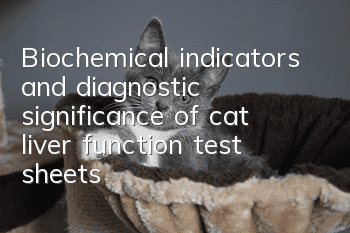Biochemical indicators and diagnostic significance of cat liver function test sheets

The general physical examination of cats has become common, but many parents are confused when holding the laboratory test sheets for cats. They only know the increase or decrease in the test results, but do not know the reasons for the increase or decrease. I hope the following simple analysis will be useful to you.
Many cat parents and mothers are confused when they have their cat’s test report. The reason is that they only know whether the result is higher or lower, but they don’t know the reason for the increase or decrease. I hope the following simple analysis will be useful to you.
Biochemical indicators and diagnostic significance of liver function:
When potassium K (normal value 3.8-4.6 Mmol/L) is higher than the normal value, it can be seen in adrenocortical insufficiency, acute and chronic renal failure, shock, tissue crush injury, severe pus and blood, oral or Injecting too much potassium-containing solution, etc. Lower than normal values are common in severe diarrhea and vomiting, after use of diuretics or insulin.
When sodium Na (normal value 147-156Mmol/L) is higher than the normal value, it is common in severe dehydration. When it is lower than the normal value, it is common in gastrointestinal sodium loss, such as vomiting and diarrhea. Severe pyelonephritis, tubular damage, diabetes, and diuretic use.
When chlorine CL (normal value 110-123Mmol/L) is higher than the normal value, it is seen in acute and chronic glomerulonephritis, heart failure, and excessive chloride intake. Lower than normal values are seen in severe diarrhea, vomiting and polyuria.
When alanine aminotransferase ALT/GPT (normal value 1-64 U/L) is higher than the normal value, it is seen in cats with infectious peritonitis, liver abscess and bile duct obstruction, cardiac insufficiency, severe anemia, and shock.
When aspartate aminotransferase AST/GOT (normal value 0-20 U/L) is higher than the normal value, hepatobiliary system diseases will increase but not significantly, mainly due to muscle damage and degeneration.
When the total protein TP (normal value 58-78 g/L) is higher than the normal value, dehydration and diseases can increase immunoglobulins. Lower than normal values are seen in increased consumption due to malnutrition, liver disease and nephrotic syndrome.
When the albumin ALb (normal value 26-41g/L) is higher than the normal value, it is seen in dehydration. When it is lower than the normal value, it is seen in malnutrition, decreased protein synthesis ability caused by liver system lesions, nephrotic syndrome and other causes of albumin loss. disease.
When albumin/globulin A/G (normal value 0.5-2.2:1) is lower than normal, it is seen in damage to liver cells and reduction in the protein production function of the liver.
Total bilirubin T. When bil (normal value 2-10 Umol/L) is higher than the normal value, it is seen in Leptospira, Fasciola hepatica, acute and chronic hepatitis and bile duct obstruction, acute jaundice, liver atrophy, and liver cancer. Sexual hemolytic jaundice is seen in anemia when the value is lower than normal.
Direct bilirubin D. bil(normal value 0-2 Umol/L) higher than the normal value is seen in bile duct obstruction in the jaundice stage of liver disease. Anemia is seen when the value is lower than normal.
When lactate dehydrogenase LDH (normal value 63-273 U/L) is higher than the normal value, it is seen in trauma, muscle disease, and liver disease. Meaningless when lowered.
When acid phosphatase ACP (normal value 0.31-2.1 U/L) is higher than the normal value, it is seen in trauma or muscle disease, bile duct obstruction, intrahepatic bile stasis, bile duct obstruction, accumulation, and malignant tumors. Meaningless when lowered.
When alkaline phosphatase ALP (normal value 2.2-37.8 U/L) is higher than the normal value, it is seen in bile duct obstruction, intrahepatic cholestasis and bile duct obstruction. Fracture healing period, malignant tumors. Drug induced.
γ-Glutamic acid aminotransferase γ-GT (normal value 1.3-5.1 U/L) is seen in hepatotoxic cholestasis, kidney disease, and pancreatitis when it is higher than the normal value. Meaningless when lowered.
- Is it really good to train a cat to use the toilet on the toilet?
- The Difference Between Maine Coon Cats and Forest Cats
- What to do if cats tear down your home? You can try these four tricks
- Black lumps on cat’s nose
- Is there a big problem with cats having unformed stools? What are the possible causes?
- How to tell if a Ragdoll cat is pregnant?
- What are the signs that a pet cat is in heat?
- What are the signs that a cat is sad?
- What are the characteristics of domestic cats?
- Are Maine Coon cats clingy?



